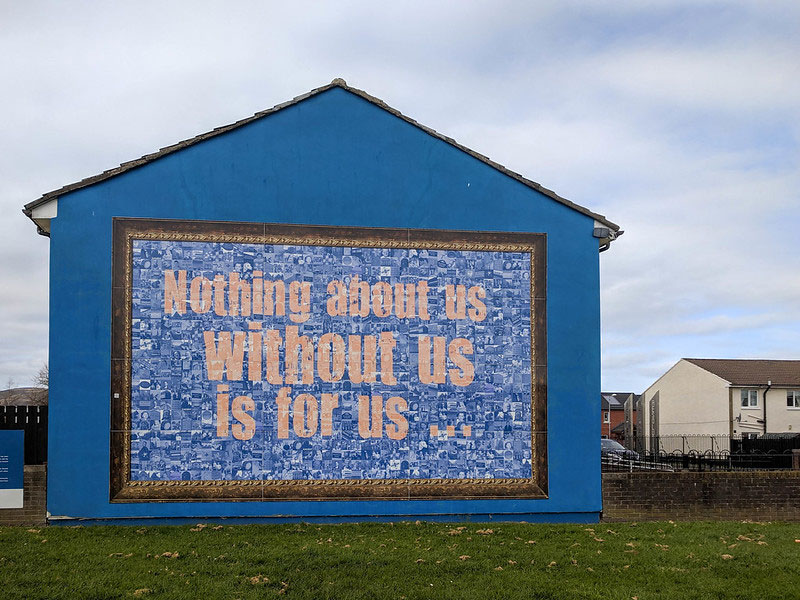Editors’ note: This article was originally published on NPQ’s website, on January 30, 2013.
Many groups are interested in convening colleagues to build an online hub of shared resources that will get members “on message,” but few invest the necessary time, energy, and financial resources to have an impact. Reflecting on their work over the past four years, the Security and Rights Collaborative, a Proteus Fund initiative, recently released a report, Building a Field-Wide Communications Hub: Lessons Learned, describing how a network of organizations concerned about Islamophobia went about reframing the public discourse on the “war on terror” and progressive national security policy.1 The report makes for an outstanding case study for any organization seeking to impact the national dialogue and public policy by engaging a cohort of nonprofits.
The Problem: Lack of a Unifying Frame
In 2008, the Security and Rights Collaborative was launched as a donor collaborative with the overall goal of impacting how policies being enacted in the name of U.S. national security were affecting fundamental human rights, particularly those of Arab, Muslim, and South Asian communities. Proteus Fund Program Officer Dimple Abichandani, who has led the collaborative since its inception, understood that to impact public policy, the collaborative needed to focus on the role that the media had played in shaping the national dialogue regarding national security and human rights.
“The shared perception of donors and organizers working in the field [of security issues] was that few voices in favor of civil rights protections were breaking through in the mainstream media,” explained Abichandani. “Our first step was to understand whether that perception was true.”
The collaborative hired ReThink Media to undertake a needs assessment of approximately sixty national security and human rights organizations to evaluate their communications capacity, determine what resources were already available to them, and clarify what messages were being used. The overall findings were that the field was lacking basic capacity.
“The gaps were different across different types of organizations,” said Abichandani. “Large organizations often had communication staff, but they weren’t necessarily dedicated to this issue. Smaller, grassroots think tanks often didn’t have communications staff, and there was little coordination with others across the field. Sixty-two percent of grantees lacked communications staff, 76 percent didn’t have a media database or distribution system, and most lacked press pages and press lists. Most organizations had worked with PR firms, so relationships with the press were all being outsourced, yet grantees had a strong desire to build their own internal media capacity.”
The collaborative also commissioned a media audit. It found that, in contrast to the opposition, which had one frame that resonated in the media across a variety of issues (from torture to racial profiling to indefinite detentions at Guantanamo Bay), the collaborative’s grantees had not effectively connected national security concerns to the protection of human rights and civil liberties.
“When our grantees were breaking through in mainstream media,” said Abichandani, “they were not on the same page with their messaging. Two or three different groups would go out with messages that didn’t point to any overarching frame. On the other side, we were being beaten by this very consistent, overarching message: tie any new policy back to the need to keep America safe.” The result was a very strong echo chamber effect in favor of the opposition’s position.
The Model: Building Capacity for Effective Collaboration
In the assessment of the collaborative, it wasn’t enough just to invest in message development. The collaborative needed a method to translate the best thinking about messaging into the echo chamber, and an infrastructure that would encourage ongoing coordination across organizations. Working with ReThink Media, the collaborative developed a model that had three primary components:
- Capacity building for individual organizations. Communications outcomes were designed to work through existing organizations, building on their skills and the effectiveness of staff and leadership. Participating organizations received online training resources, webinars, in-person training, coaching, and consulting in both traditional and new media.
- Shared access to a media database, including shared press lists. Hub members were given access to a state-of-the-art, continually updated media database of 800,000 national and international media contacts. The web-hosted database is coupled with a distribution system that allows users to readily customize media lists, enabling both quick responses to breaking stories and more advanced planning to frame issue coverage.
- A mechanism for rapid response to breaking stories. Hub participants received daily news clips and a shared calendar of upcoming events and news hooks, opposition messaging analysis, and the latest polling and public opinion data. When a big story broke on an issue relevant to the field, ReThink sent breaking news alerts and often hosted a strategy call so that advocates could share resources, update each other on their plans, and identify opportunities for action.
“We put a lot of effort into building the model so that it provided resources that people needed,” said Abichandani. “For example, we have a daily e-mail that has all the day’s news clippings across a number of issues. It saves everyone hours and hours of time going through all these articles themselves.” Abichandani credits field uptake of the communications hub with much of the relationship building that ReThink Media conducted early on in the project. Most of the hub’s first year was focused on working with individual groups to develop trust and to build a minimum baseline of capacity within each organization. Given the range in organizational capacity, the collaborative made it a priority to offer resources that various groups could use differently, rather than trying to force a one-size-fits-all approach.
For those that may be interested in developing their own collaboration and communications hub, ReThink Media founder Peter Ferenbach cautions against adopting an “if you build it, they will come” mindset: “People have full-time jobs and lines of accountability in their own organizations. Participating in an online community is often some other thing outside of their daily work flow. Unless you’ve conjured up a way to demonstrate real value and engage it into their work flow, there’s no way to leverage that resource into daily engagement.”
Sign up for our free newsletters
Subscribe to NPQ's newsletters to have our top stories delivered directly to your inbox.
By signing up, you agree to our privacy policy and terms of use, and to receive messages from NPQ and our partners.
The collaborative invested a little over $400,000 in messaging research and more than $500,000 in setting up the communications hub. Maintenance of the hub requires about $500,000 annually. In addition, the collaborative makes capacity building grants to individual organizations. In 2012, fifteen organizations received grants ranging from $20,000 to $70,000. It’s an investment that Abichandani thinks is money well spent.
“It didn’t make sense to tackle these issues by doing one-by-one communications grants,” said Abichandani. “If we had supported the hiring of ten communications directors in the field, we would have invested roughly the same amount but wouldn’t have gotten to the echo chamber effect that we got by supporting a shared communications infrastructure and working with the groups themselves. One of the things we decided early on was to work with a set of existing organizations to amplify their voices.”
The Results: Changing the Narrative and Enabling Stronger Advocacy
Abichandani admits that when the hub was first launched, there was a question as to whether the larger civil rights groups would participate. “The big groups showed up and even sent their senior staff, participating actively,” she said. “They recognized that the hub was an opportunity for them to recruit additional support for their efforts.” One of the findings of an early media audit was that when issues were discussed, the language used was often very legalistic and therefore inaccessible. Large groups needed stories of how policies and developments directly impacted people’s lives, while small organizations needed the help of the larger groups to steer the national conversation.
One of these organizations, The Sikh Coalition, credits the Security and Rights Collaborative with shaping how the media reported on the breaking news of the August 2012 mass murder at a Sikh temple in Oak Creek, Wisconsin. The shooter, reportedly a white supremacist, killed six people and wounded four others. Immediately following the incident, Sikh Coalition co-founder Amardeep Singh was on the phone with ReThink Media, developing and issuing a press release. “By the next day, the other members of the collaborative were receiving messages that we could all use in addressing this issue across the sector,” said Singh. “We were on CNN and other national outlets, helping to address the message and constantly issuing press releases. As a result, we helped to shape the government’s response. By that Friday, the Attorney General had declared the incident a hate crime. I don’t know what we would have done without the hub.”
The collaborative has also helped shape news events by planning ahead for news stories. In December of 2010, Peter King, chairman of the House Committee on Homeland Security, announced a series of congressional hearings, scheduled for March of 2011, to probe the “radicalization of the American Muslim community.” The hearings posed multiple threats to the community, including inflaming hatred and bias against Muslims. Over ten weeks, ReThink Media and the collaborative held weekly conference calls to develop messaging and implement a strategic communications plan that included an op-ed strategy and a Capitol Hill strategy, placing spokespeople and compiling quotes from expert witnesses. The result, according to the Proteus Fund research, was that the collaborative’s position dominated the op-ed and editorial coverage at the top thirty national and regional newspapers in the country, with 70 percent of op-eds opposing King, and the most influential papers—the New York Times, the Washington Post, USA TODAY and the Los Angeles Times—all editorializing in favor of the collaborative’s position.
Kathryn Casa, director of communications at ACCESS, a national Arab American human services organization, sees a direct link between the collaborative’s efforts and her own organization’s ability to influence public discourse. “We often use media clips to help us in our own blogs and social media postings,” said Casa. “The trainings have been very useful for us to increase our own capacity and allow us to earn more media. We were able to utilize talking points around the Peter King hearings to help us in our messaging.”
Casa credits the collaborative’s capacity-building work with making the resources usable. “Without having capacity to bring on a part-time communications staff person, we wouldn’t have enhanced our communications work despite additional training, talking points, media lists, social media activity, etc.,” she said. “Not only has this resource enabled us to react more efficiently and quickly, we can now plan better so that we’re not always reacting. It was more forward looking, instead of reacting to the slings and arrows of the last decade, and it has enhanced our ability to be leaders.”
Nadia Tonova, the director of the National Network for Arab American Communities, a program of ACCESS, also points to increased engagement with other members as a positive outcome of the collaborative. “There’s more coordination among the field. I know that other folks have been able to improve their communications capacity,” she said. “It has helped all of us move forward at the same time to be on the same page with our work. It makes us stronger advocates.”
NOTE
- The Security and Rights Collaborative, Building a Field-Wide Communications Hub: Lessons Learned, http://www.proteusfund.org/src/reports.
John Hoffffman, MBA, has more than fifteen years of experience in marketing and development within the nonprofit and technology sectors.













